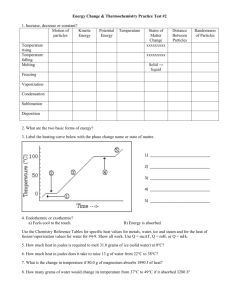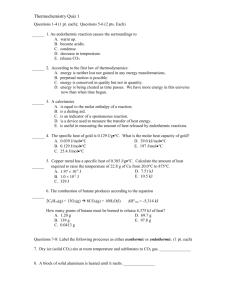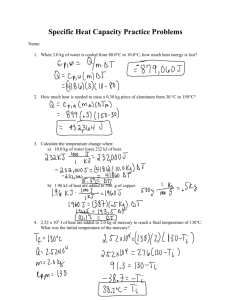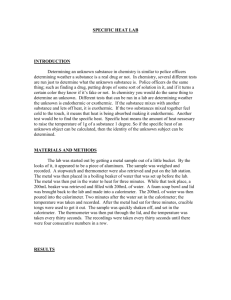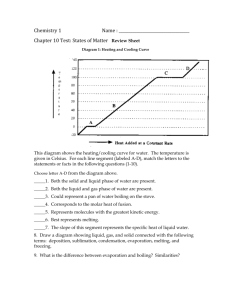File
advertisement
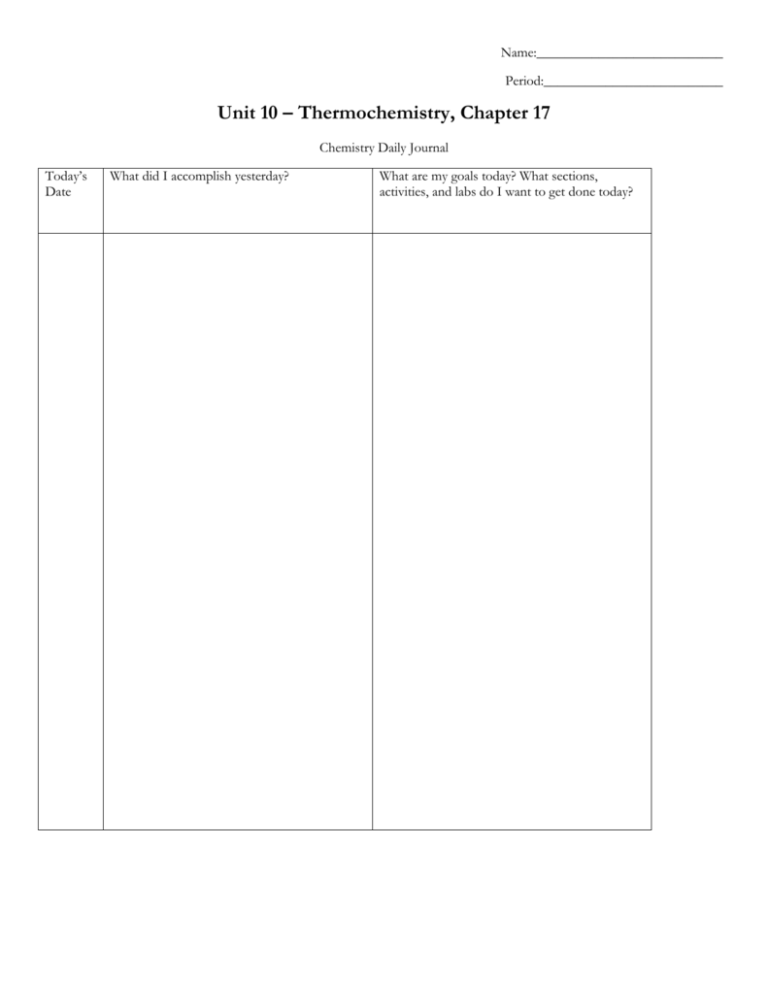
Name:___________________________ Period:__________________________ Unit 10 – Thermochemistry, Chapter 17 Chemistry Daily Journal Today’s Date What did I accomplish yesterday? What are my goals today? What sections, activities, and labs do I want to get done today? Objective 10.1 Distinguish between Exothermic and Endothermic Processes 10.2 Relate Heat Capacity and Specific Heat to changes in temperature 10.3 Perform calorimetry to determine the quantity of heat for an object. 10.4 Calculate heat based on Hess’s Law of Summation Learning Opportunities □ □ □ □ □ □ □ Read p. 503-510 The Flaming Snowball Demo □ Answer #9, 10, and 11 p. 510 and 12-13, p. 513 Interpreting Graphics 17.2 Specific Heat of Metals Lab Answer # 15, p. 516; #18 and 19, p. 517; and 35, p. 532 Hess’s Law Practice Problems 32 a and b, p. 531 and #37, p. 532 Thermochemistry: Standard Heats of Formation Worksheet Heat in Changes of State □ □ □ □ 10.5 Evaluate the heat of reaction using Hess’s Law of Enthalpy □ □ 10.6 Define and calculate enthalpy for changes in state. □ Answer # 1 and 2, p. 507; 5, 6, 7, p. 510 Ice Cream Lab Heat Capacity Demo Answer #3, 4, and 8 p. 510 Flaming Snowball Demo! Please write and/or draw your observations in the space provided below. Suggested Due Date Date Completed Name: ________________________ Per: _____ Date: _______________ Thermochemistry Ice Cream Lab Questions: 1. Record your qualitative observations for this lab. What happened? 2. How would you define the system in the ice cream experiment? 3. What would you consider the surroundings in the ice cream experiment? 4. The ice cream in the inner bag freezes during the course of this lab. Explain the flow of energy between the system (consisting of the ice cream mixture in the inner bag) and the surroundings (the salt/ice/water mixture in the outer bag). 5. Is the melting of the ice an exothermic or endothermic process? 6. Is the freezing of the ice cream an exothermic or endothermic process? 7. Identify if the following processes are endothermic or exothermic. Melting ice cubes – Condensation of rain from water vapor – A candle flame – Cooking an egg – Burning sugar – Mixing strong acids and water – Conversion of frost to water vapor – Melting solid salts – Combustion of hydrogen gas – 8. How would your ice cream have been different if only ice were used instead of the ice/salt mixture? Briefly explain. 9. Why is salt placed on icy patches on highways, sidewalk and steps in the winter (where it actually gets cold enough to freeze)? SPECIFIC HEAT OF METALS LAB Chemists identify substances on the basis of their chemical and physical properties. One physical property of a substance is the amount of energy it will absorb per unit of mass. This property can be measured quite accurately and is called specific heat (Cp). Specific heat is the amount of energy, measured in joules, needed to raise the temperature of one gram of the substance one Celsius degree. Often applied to metallic elements, specific heat can be used as a basis for comparing energy absorption and transfer. To measure specific heat in the laboratory, a calorimeter of some kind must be used. A calorimeter is a wellinsulated container used in measuring energy changes. The calorimeter is insulated to reduce the loss or gain of energy to or from the surroundings. Energy always flows from an object at a higher temperature to an object at a lower temperature. The heat gained by the cooler substance equals the heat lost by the warmer substance, if we assume no loss of heat to the surrounding environment. heat lost = heat gained In this experiment, you will determine the specific heat of a metal sample. The metal sample will be heated to a high temperature then placed into a calorimeter containing a known quantity of water at a lower temperature. Having measured the mass of the water in the calorimeter, the temperature change of the water (∆T), and knowing the specific heat of water (4.184 J/g°C), the heat gained by the water (lost by the metal) can be calculated as follows: Heat gained by = Mass of x Specific heat of the water water (g) water (4.184 J/goC) The specific heat of the metal can now be calculated: Specific heat of metal (Cp) = heat gained by the water (J) . mass of metal"(g) x ∆T of metal (°C) x Change in temperature ∆T (Co) Objectives In this experiment, you will • measure the mass and temperature of water in a calorimeter, • heat a metal sample of known mass to a specific temperature, • calculate the change in water temperature caused by adding the hot metal sample, and • calculate the specific heat of the metal using your mass and temperature data. EQUIPMENT bunsen burner ring stand test tube thermometer beaker (250 cm3) balance styrofoam cup goggles oven mitt PROCEDURE 1. 2. 3. 4. 5. 6. 7. 8. 9. Fill a 250-mL beaker about half full of water. Place the beaker of water on a hot plate or a ring stand with wire gauze. Begin heating the water to the boiling point. Continue with the procedure while the water is heating. Fill a test tube with about 1.5 cm of the metal. Record the mass of the metal and identify it as Sample A, B, C, or D. Place the metal back in the test tube and immerse it in the beaker of boiling water and continue heating. Leave the metal in the boiling water bath while you complete Steps 4–6. Obtain two styrofoam cups to be used as a calorimeter and measure the mass carefully. Record in data table. Fill the plastic foam cup with just enough room temperature water to cover the cylinder. DO NOT FILL TO THE TOP. Record the mass. Measure the temperature of the water in the cup with a temperature probe. Do not add the hot metal until a steady temperature has been reached (at least 30 seconds). (It will be assumed the temperature of the metal is the same as the boiling water.) Remove the metal from the boiling water – it has to be in BOILING WATER for at least 3 minutes – and immediately pour it into the calorimeter and cover quickly. Using the thermometer, stir the water in the styrofoam cup and continue to watch the temperature and stir the water until the temperature starts to drop. Write down the highest temperature reached. Repeat steps 2 to 8 with 2 different metals. Return all metal samples to the reagent table. If your error is greater than 10%, you will need to redo the experiment for that metal. PreLab Questions 1. How many joules of heat are given off when 5.0 g of water cool from 75oC to 25oC/ (Specific heat of water = 4.184 J/goC) 2. Calculate the specific heat of a metallic element if 314 joules of energy are needed to raise the temperature of a 50.0 g sample from 25.0oC to 50.0oC. Please show calculations below, then transfer your data to the data table (use appropriate sig-figs) Post Lab Questions: 1. What physical properties, other than specific heat, could you use to identify the samples of metal used in this experiment? Explain. 2. Why is water an excellent material to use in a calorimeter? 3. Suppose that the particle size of one of the metals used is very large compared to the others. Discuss how this might lead to error in the measurement of its specific heat. 4. How is the atomic mass of metals related to their specific heats? (use chart below) Heat in Changes of State Pages 520-526 1. Read this WHOLE section to fill in the chart below: Phase Change Heat Symbol Movement of Energy Hfus Melting …of Solidification Exothermic Vaporization Endothermic Hcond Sublimation …of Deposition Use the chart below to answer the following four questions: 2. Label the melting point and boiling point temperatures on the graph. 3. In which region(s) of the graph is temperature constant? 4. How does the amount of energy required to melt a given mass of ice compare to the energy required to vaporize the same mass of water? Explain. 5. Which region of the graph represents the coexistence of solid and liquid? Liquid and vapor? 6. What is molar heat of solution? 7. Give an example of an exothermic heat of solution and an endothermic heat of solution. Unit 9: Test Review You may make one 3x5 note card. It must be hand written and you can use the front and back. This review MUST be completed before you take your test. It will help you prepare. 1. Review all the vocabulary words for this chapter. Know everything on your crossword puzzle! 2. Explain in your own words the law of conservation of energy. 3. What always happens when two objects of different temperatures come in contact? In which way does the energy/heat flow? 4. Define potential and kinetic energy in terms of chemistry. 5. What is the relationship between a calorie and a Calorie? 6. Make the following conversions. a. 8.50 × 102 cal to Calories b. 444 cal to joules c. 1.8 kJ to joules d. 4.5 × 10-1 kJ to calories 7. Two substances in a glass beaker chemically react, and the beaker becomes too hot to touch. Is the reaction exothermic or endothermic? If the two substances are defined as the system, what constitutes the surroundings? 8. Classify these processes as exothermic or endothermic. a. condensing steam b. evaporating alcohol c. burning alcohol d. baking a potato 9. The specific heat of silver is 0.24 J/g⁰C. How much heat in joules must be added to a liver block of mass 86.0 g to raise its temperature by 9.00⁰C? 10. An 18.7g sample of platinum metal increases in temperature by 2.30⁰C when 5.70 J of heat are added. What is the specific heat of platinum? 11. In an experiment, a group found that 3 L of water went from 20⁰C to 30⁰C. They burned 3.0g of methane to cause this temperature change. How much thermal energy did the water in this experiment absorb? 12. What is the SI unit for heat? 13. What name is given to a heat change at constant pressure? 14. What is the function of a calorimeter? 15. Give the standard conditions for heat of combustion. 16. What information is given in a thermochemical equation? 17. Hfus is equal to -Hsolid. What is Hvap equal to? What is Hdep equal to? 18. Sodium acetate dissolves readily in water according to the following equation. NaC2H3O2(s) → NaC2H3O2(aq) ΔH = −17.3 kJ/mol Would this process increase or decrease the temperature of the water? How much heat will be transferred when 3.5 mol of NaC2H3O2 goes through the phase change? 19. How much heat will be absorbed with 13.7g of Nitrogen reacts with excess O2 according to the equation N2 + O2 2NO + 180kJ? 20. How much heat will be transferred when 5.81g of graphite reacts with excess H2 according to the equation 6C(Graphite) + 3H2 + 49.03 kJ C6H6? 21. Explain Hess’s law of heat summation. 22. Calculate the enthalpy change for the formation of lead(IV) chloride by the reaction of lead(II) chloride with chlorine. PbCl2(s) + Cl2(g) → PbCl4(l) Use the following thermochemical equations. Pb(s) + 2Cl2(g) → PbCl4(l) ΔH = −329.2 kJ Pb(s) + Cl2(g) → PbCl2(s) ΔH = −359.4 kJ 23. Determine H for N2H4(l) + 2H2O2(g) N2(g) + 4H2O(l) using the listed enthalpies of reaction: N2H4(l) + O2(g) N2(g) + 2H2O(l) H = -622.3 kJ H2(g) + ½O2(g) H2O(l) H = -285.8 kJ H2(g) + O2(g) H2O2(l) H = -187.8 kJ


